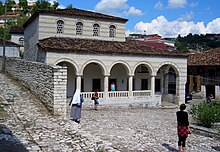Halveti
The Chalweti - or Halveti - Tariqa ( Arabic : Chalwati or Khalvati ) is a mystical Sufi order . Its founder is Pir Umar Halveti (Abu Abdallah Siradschuddin Umar Ibn Akmaluddin al-Lahdschi al-Chalwati; † 748 H / 1347 AD ). From Umar Halveti, the spiritual chain (in Arabic Silsila ) can be traced back to the Prophet Mohammed via Zahed Gilani , Suhrawardi , Junaid of Baghdad , Hasan al-Basri and ʿAlī ibn Abī Tālib . The order was founded in Herat in what is now Afghanistan.
The term Halvet (Arabic Chalwat ) is used by the Sufis in connection with “retreat into prayer” and “devotion”. The form Halveti denotes someone who practices Halvet .
founding
Already during the time of Sheikh Sayyid Yahya Schirvani († 1457/58 in Baku ), the direct successor of Pir Umar Halvetis, the number of dervishes grew considerably. Yahya Schirvani's deputy then spread the tariqa over the entire Muslim world, especially in Anatolia and the Balkans , it was very popular.
Over time, four major branches emerged:
- the Jamalis , founded by Jamal Chalwati († 899 H / 1493 AD), also known under the name " Tschelebi Chalifa".
- the Ahmadis , founded by Ahmad Schamsuddin Marmaravi († 910 H / 1504 AD).
- the Ruschanis , founded by Dede Umar Ruschani († 892 H / 1486–1487 AD in Tabriz ).
- the Sivasis (or Shamsis), founded by Shamsuddin Ahmad Sivasi († 1006 H / 1597–1598 AD in Sivas ).
development
Within the four directions there were numerous other splits, at the end of the 19th century the Halveti-Tariqa consisted of around 50 different brotherhoods, each of which is considered to be part of the Halveti-Tariqa or an independent order according to different views. They correspond in their beliefs and Dhikr ceremonies. The Halveti-Tariqa also include a number of notable Ottomans, including 15 sultans , as well as the historian Ahmed Cevdet Pascha from the 19th century († 1825). This does not mean, however, that this is a tariqa of the educated elite. Rather, a lot of the dervishes of that time come from every imaginable social class. According to a study from the 19th century, there were in Istanbul 89 Halveti- at that time tekkes , compared with 22 Naqshbandi - five Mevlevi - and three Shadhili -Tekkes.
In the European part of the Ottoman Empire, the Halveti dervishes were represented in all provinces with a strong Muslim population. So they entertained Tekkes in Sarajevo , Skopje and in the Albanian Berat.
Situation today

In today's Turkey , despite the official ban by the country's founder Mustafa Kemal Ataturk still three Halveti branches in 1925 to entertain dervish centers active: the Schabanis that Dscherrahis and Uschschakis . The number of dervishes in these three groups is greater than that of any other tariqa at the beginning of the 21st century. In Kastamonu , Pir Şeyh Şaban-i Veli, who died in 1568/69, is venerated in a Türbe on the site of Halveti-Tekke.
The Halveti-Tariqa is also the largest of the Tariqas still active today in the Balkans (e.g. Hayati-Halveti in North Macedonia ).
See also
literature
- Nathalie Clayer: Networks of Muslim Brotherhoods in Southeast Europe . European History Online , ed. from the Institute for European History (Mainz) , 2011, urn : nbn: de: 0159-2012042606 .
- Yaşar Nuri Öztürk : The Eye of the Heart. An Introduction to Sufism and the Tariqats of Anatolia and the Balkans . Chapter Eleven: The Khalwatis. Redhose Press, Istanbul 1988, ISBN 975-413-024-8 .
